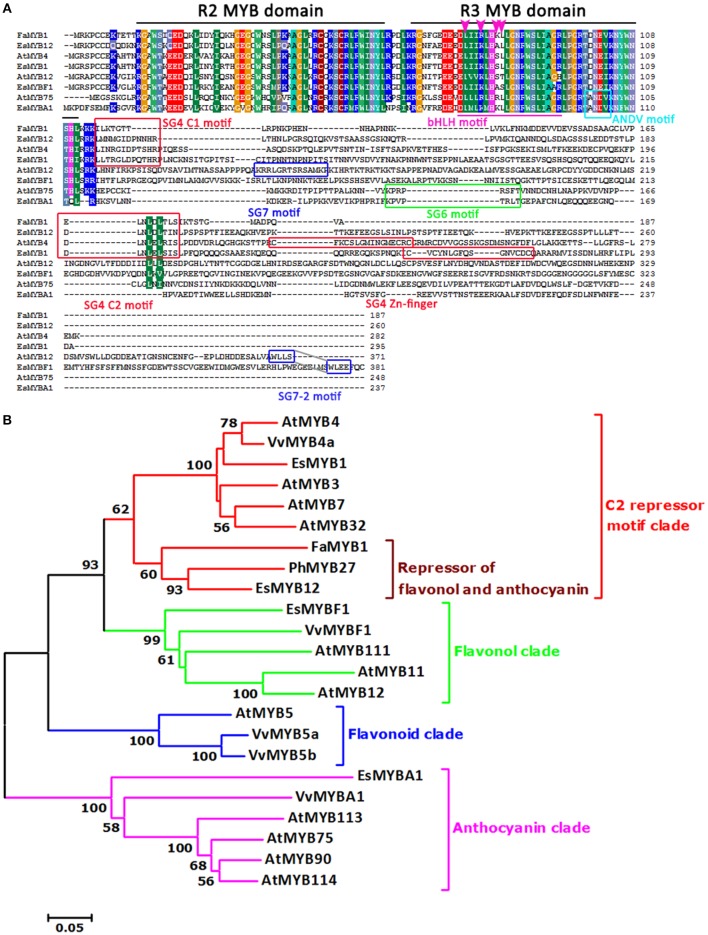Figure 2.
Multi-alignment and phylogenetic relationship of four R2R3-MYB transcription factors from E. sagittatum with other plant MYB regulators of the flavonoid pathway. (A) Alignment of the deduced amino acid sequences of four Epimedium R2R3-MYB proteins and other known plant R2R3-MYB proteins. Identical amino acid residues are shaded in the same color. In addition to the R2 and R3 MYB domains (black lines), the bHLH interaction motif (purple underline) are present in all four EsMYB proteins. The four amino acid residues (LxxRxx[K/R]L) required for the interaction with the maize bHLH protein R is present in EsMYBA1 and marked with an arrowhead. The red boxes represent three conserved motifs, subgroup (SG) 4 C1 (LlsrGIDPx[T/S]HRx[I/L]), SG4 C2 (pdLNL[D/E]Lxi[G/S]) which both are present in the EsMYB1 and EsMYB12 proteins, and SG4 Zn-finger motifs (Cx1−2Cx7−12Cx2C) only present in the EsMYB1 protein. The green and cyan box indicate the SG6 (KPRPR[S/T]F) and ANDV motif, respectively, and both are present in the EsMYBA1 protein. The blue boxes represent the SG7-2 (WLLS) motifs present in the EsMYBF1 and AtMYB12 protein, and the SG7 (KRR[L/p]GRT[G/S]RSAMK) motif present in the AtMYB12 protein. (B) The phylogenetic relationship of four Epimedium R2R3-MYB with selected known R2R3-MYB proteins from other plant species using the neighbor-joining method in the MEGA 5 software. The scale bar represents the number of substitutions per site and the numbers next to the nodes are bootstrap values from 1000 replicates, and the values below 50 are not shown. The putative regulatory functions of the R2R3-MYB proteins are indicated, and five distinct clades are formed. All R2R3-MYB protein sequences were retrieved from the GenBank database and accession numbers are as follows: Epimedium sagittatum: EsMYB1 (AFH03053), EsMYB12 (AFH03064), and EsMYBA1 (AGT39059); Arabidopsis thaliana: AtMYB3 (NP_564176), AtMYB4 (NP_195574), AtMYB7 (NP_179263), AtMYB32 (NP_195225), AtMYB11 (NP_191820), AtMYB12 (O22264), AtMYB111 (NP_199744), AtMYB5 (NP_187963), AtMYB75 (AtPAP1, AAG42001), AtMYB90 (AtPAP2, AAG42002), AtMYB113 (NP_176811), AtMYB114 (NP_176812); Fragaria x ananassa: FaMYB1 (AAK84064); Petunia x hybrida: PhMYB27; Vitis vinifera: VvMYB4a (ABL61515), VvMYBF1 (ACV81697), VvMYB5a (AAS68190), VvMYB5b (AAX51291), and VvMYBA1 (BAD18977).

